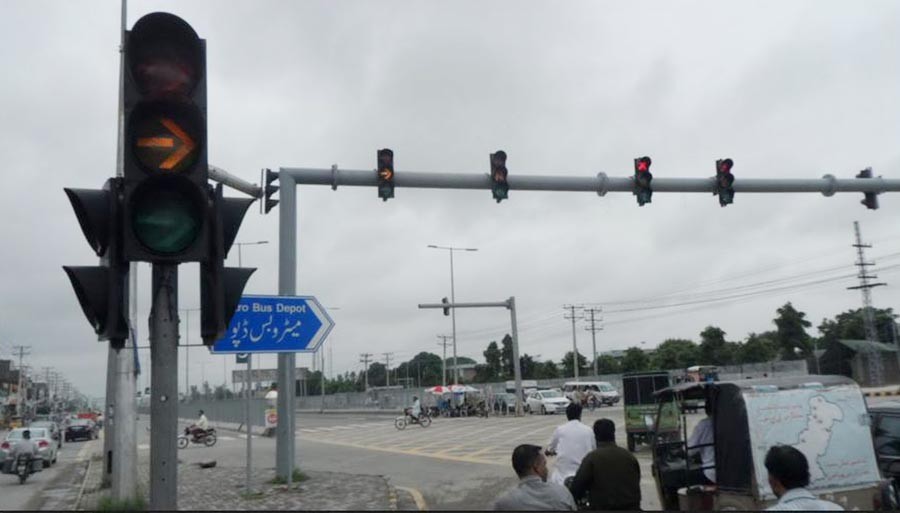
Fake number plates and stale database of vehicle owners are some of the major issues preventing the Punjab Safe City Authority from enjoying the fruits of the e-challan system

Stale vehicular data, wrong traffic engineering in the past, faulty designs of underpasses and U-turns, and poor traffic signage on the roads are creating problems in the implementation of the e-challan system across the provincial metropolis.
The e-challan system was designed to detect all kind of traffic violations through an integrated electronic network of cameras by the Punjab Safe City Authority (PSCA) and was implemented in the last quarter of 2018. Through this system, traffic violators receive e-challans at the addresses associated with the vehicles. However, one of the biggest hurdles being faced by the PSCA in carrying out its task is a stale database of vehicle owners. According to the Chief Traffic Officer (CTO) Capt (retd) Liaqat Ali Malik, the total number of registered vehicles (cars, bikes, rickshaws etc) in Lahore is almost 55.8 million whereas around 0.4 million vehicles registered in other cities also enter the metropolis every day.
The CCTV cameras installed at the main crossings/points monitor traffic violations such as wrong U-turns, breaking the signal, over speeding and abrupt line change. Senior traffic officers monitor the violations and later an e-ticket is generated and sent to the culprit via courier service.
"The total length of all roads in Lahore is around 1,772 kilometres on which motorbikes (65 percent of the total vehicles) are supposed to use the extreme left lane. Unfortunately, the option of the third lane is not available on the major roads of the city," he says.
The traffic police can’t stop a biker from changing lane because of the presence of traffic signals/U-turns at shorter distances. Giving an example, he says that if a biker crosses Faisal Chowk and wants to take a U-turn from Hall Road, he will naturally ride in the extreme right lane, which is dedicated for cars to overtake. In case he takes the extreme left lane, he will diagonally move towards the signal of Hall Road and the camera will detect him as a violator of line and lane.
"In the year 2018, traffic police issued 1,316,073 challans of motorbikes, out of which 264,210 were due to lane/line changes, 474,325 were related to not wearing helmet," says the CTO, adding that the traffic police has already requested the Punjab government to give 25 percent share of a challan to the traffic police so that it can upgrade its infrastructure including vehicles. The Motorway police and Ring Road Authorities are already getting a fixed percentage of fines and challans that they issue in their respective jurisdictions.
On the other hand, after successfully implementing the first phase of the e-challan system in Lahore, the PSCA has extended its scope by including violations in speed limit and lane changes. (Previously, the violations were related to one-way and red-light violations only.)
"Our speed cameras are running 24/7, and the perception that they do not record data after midnight is totally wrong," says Akbar Nasir Khan, Chief Operating Officer (COO) at PSCA.
He denies the rumour that the e-challan system is not working properly.
Cloned number plates, stale data of vehicle owners, manual operation of traffic signals at peak time, are some of the major issues the PSCA is facing.
It is interesting to mention that over 60,000 e-challans of motorbikes have been issued so far, but the ratio of the actual fine submission remains low. Khan says that the general holdup of bikes is against the policy of the PSCA: "We will conduct a targeted operation against defaulters," he declares. "The commuters should also help the PSCA by getting their home addresses corrected with the Excise and Taxation department."
Talking about the upcoming point system, Khan says that the PSCA is educating the public through its visual messaging screens about speed limits on different roads of Lahore. "An amendment in traffic laws is long overdue. After this anyone reaching 20 points shall have to face suspension of their traffic license temporarily or permanently."
For the traffic on Canal Road, the speed limit for Light Transport Vehicle (LTV) and Heavy Transport Vehicle (HTV) is 70kms and 50Kms per hour respectively. The speed limits for LTV and HTV on The Mall, Jail Road, Ferozepur Road and Gulberg Main Boulevard are 60km and 40km per hour respectively.
Rana Arif, spokesman Traffic Police, says that those ticketed must pay fines timely to avoid further action.
According to Arif, the framework for e-challan defaulters also applies to those who tamper with or hide the registration numbers of their vehicles to evade challan-calibrated cameras.
He says that the citizens can visit echallan.psca.gop.pk to check the status of e-challans against their CNICs and vehicle registration numbers. If a person other than the vehicle owner has violated the traffic rules and the e-challan is sent to the vehicle owner, the latter will be considered responsible for the incident.
The new measures of PSCA and Traffic police seem to be working, considering how the number of violators has come down considerably. The vehicle owners need not panic if they get e-challan for a vehicle they have sold already, because this might be due to non-transfer of their vehicle papers.